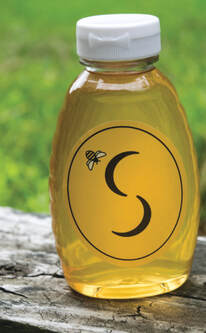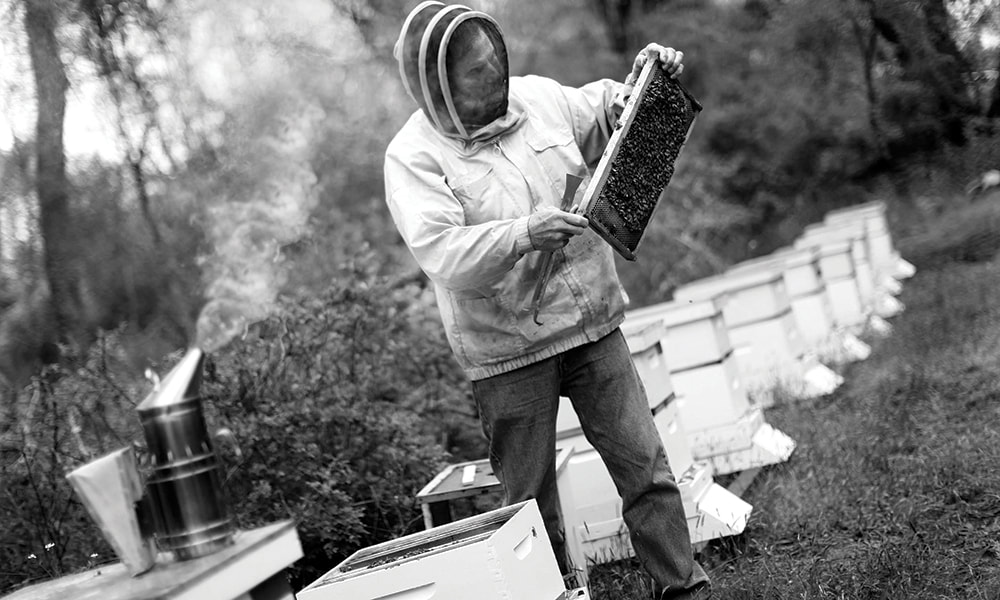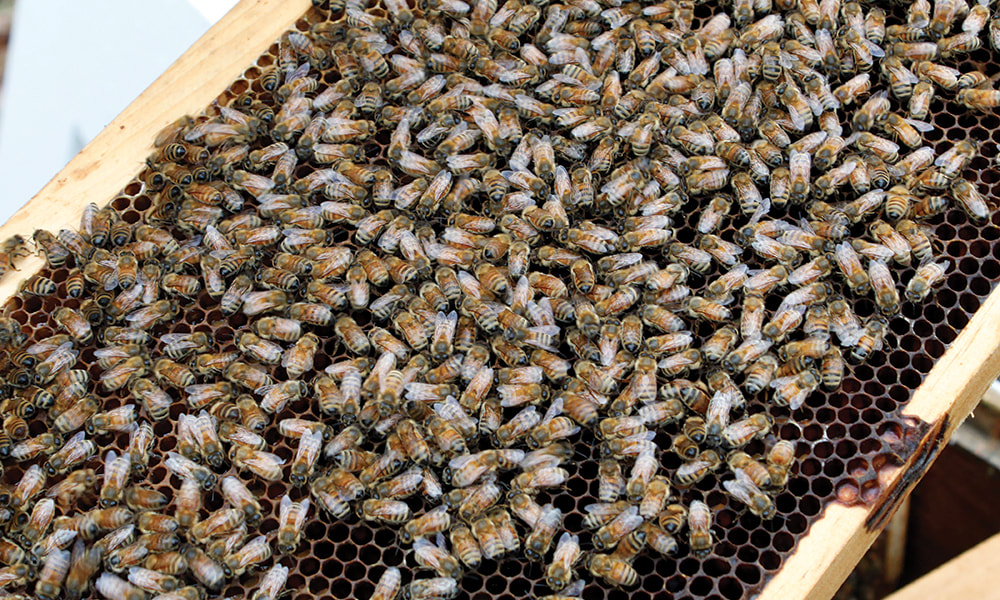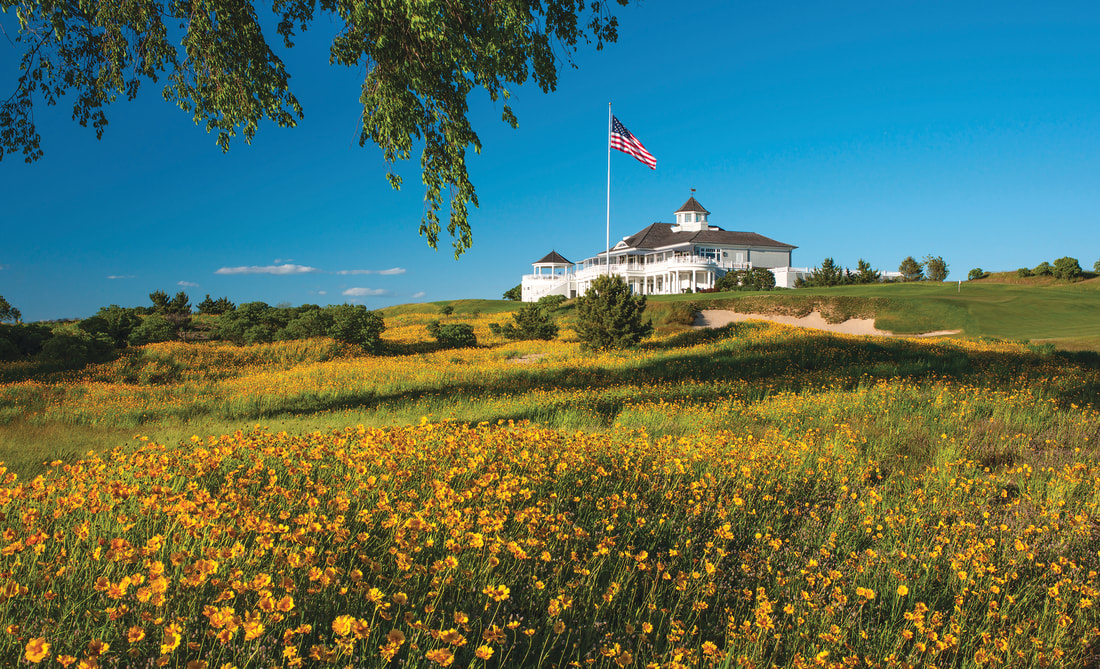|
John Carson inspects a frame from one of the Sebonack hives. Image by Michael J. Fiedler www.working-journal.com John Carson’s dedication to bees and their impact on the environment has fascinated me since my first conversation with him in 2014 at Sebonack Golf Club during the installation of the hives. I returned this year to see how the colonies were progressing and asked Carson a few questions about his work. ~ Diana DeLucia GK: Why bees? Somewhere in my 20’s, I started keeping honeybees. I am mesmerized by them, and managing hives has become a significant part of my life. GK: What do you do in your average day, is it your full-time job? No, it is not my only job, I own a farm stand in Westhampton, New York. I get up early every day, and I take care of everything I have to do for the farm stand, I’m usually done by nine a.m. I have people that work there and manage it while I go and take care of the bees and, you know, they need a lot of attention. It’s not all year round, but in the springtime, it’s hectic. GK: How do you feel about the food industry and the honey that you’re producing? There is a lot of suspect honey on the market. It is big news right now. There is a lot of honey that isn’t real, and it’s either filtered beyond the point of being honey, or it’s mixed with high fructose corn syrup. The honey that we are producing is 100% raw. It’s never been heated, and it’s never been filtered. It comes from the bees to the jar, and I oversee the entire operation.  GK: Is it true that the honey in your local area is the best to eat? It depends, I have a whole theory on this. A lot of my customers at the farm stand and other places eat raw honey because of their allergies. I don’t think there is any medical or scientific explanation, but when somebody comes to me, and they say, “oh, I have allergies, I want to buy some honey,” I ask them, “what are you allergic to?” If they know what it is, say they’ve said they are allergic to dandelions, I’ll make sure that I give them the honey that we took from the spring because I know that the dandelions were blooming at that time. If you’re allergic to goldenrod, there’s no goldenrod in the spring, honey. So you want honey from the fall, but there’s no definite proof that this works, but nobody’s complaining. GK: Why are honey bees successful pollinators? They are species-specific. A bee colony is set up to have scouts that are looking for sources of nectar and pollen, they communicate with each other where the best sources are. For bee pollination to work, it has to come from the same species. Butterflies don’t care, they’ll go from a cucumber to a tomato to a dandelion, but you’re not going to get a cucumber that looks like a dandelion. It’s not going to happen. This is why bees are such valuable pollinators. They are species-specific. They’ll just do one thing. You could have clover honey if you knew that clover was in bloom as that’s when the bees get the nectar. GK: I heard that honey is like wine, and there are different flavors if you pay attention. Yes, that is correct, some of the honey from Sebonack Golf Club tastes like mint, and that is due to a wild mint on or around the golf course, it’s very subtle. The honey that we produce at the beginning of the season is so light that you can read a newspaper through it. The honey at the end of the season, if we get a fall crop, is such a deep, dark red that if you hold the jar up to the light, you can’t see through it. I have a vast following of people that want to buy this honey. They know it’s real. Some people only want light honey, others like crystallized honey or dark honey. Some people come to the farmstand, and we don’t have the dark honey, well, they won’t buy the light honey, they will just wait until we have the dark honey. GK: At what point did society say we want to make honey that all tastes exactly the same? There’s a lot of people on the planet. There’s no way you can produce enough food without mass production. People complain about Monsanto and Roundup and all this other stuff, but when they go into a store, and a tomato is $10, an ear of corn is $15 they’re going to be complaining about that too. You have to mass-produce. It takes a lot to feed a nation. People have this idea that we’re going to be organic farmers and we’re going to be organic farmers and we’re going to grow everything naturally, and we’re not going to use any plastic. It’s not possible without technology. The human population over the last 150 years has exploded, and everybody needs to eat, and there is a trade-off for that, there is some collateral damage, and it’s not feasible for the small production companies as they can’t produce enough, you need factories. The other thing is the actual cost of producing. The small farmers they’re on the verge of going out of business. There are regulations and all the other associated problems. It can’t keep going the way it is, and the trade-off with that will be mass-produced food. Everything will be GMO. It’s the only way they can produce enough. Beekeeping, up until the 1800s consisted of a man who found a beehive, killed it and took the honey and that worked fine back then as the demand for the honey didn’t outpace what the bees would naturally be able to produce. Then along came this guy Langstroth, and he figures out beekeeping. He invented and designed the hives that we’re using today. GK: How are they mass producing honey? What has happened recently with the bees is they went on a genetic laser beam from being natural producers to controlled hives. People figured out that you can flip generations in the summertime in a matter of weeks, and very quickly, things started to change. I really believe that one of the reasons the bees are dying is genetic. What I’m trying to do is raise queens that I select for survivability and heritability. So far it hasn’t worked. It’s like Holstein cows, you can’t take a herd of cows and let them go and figure that they’re going to be all right. The farmer has to take care of them and, I believe it’s the same thing with bees nowadays. This is only my opinion, but the single biggest problem is mites, and the vast majority of other issues that you see with bees are a direct effect of the mites. A frame from one of the Sebonack bee colonies. Image by Diana DeLucia GK: Bees are not native to America, usually when a species from another country is introduced it becomes a huge problem. Why is this different for honey bees? 90% of the food that’s pollinated is pollinated by honey bees. GK: What happened before the honeybees were introduced? Honey bees are not native to America, they were introduced when European settlers came here, mainly to make mead. The American Indians took care of themselves. So they were fine. There was nobody here. They didn’t need the food. GK: So why do people say if there are no bees, there’ll be no people. The population of the US is around 400 million people, that’s a lot of mouths to feed. The Chinese are trying to hand pollinate, but it’s too labor-intensive, remember in a healthy hive there are 40 000 to 60,000 bees, that’s a lot of work to hand pollinate. Bees are so efficient at what they do. Depending on who you ask and I personally don’t subscribe to this, but maybe it’s true, and, I think Einstein was one of them who said that the human race has between one and 10 years without bees. GK: Tell us about the mass production of honey bees. You can palletize hundreds of hives, say you have thousands of acres of almonds in California, they’ll bring these palletized hives in semi-trailers, they’ll know how many thousand acres and how many thousand colonies they need. They know when 10% of the blossoms are in bloom, and that’s when they let the bees go because the bees will go right to the flowers. GK: It sounds like what you’re saying is bees are becoming a commodity production, and that’s probably why they’re all getting sick because they’re not immune to anything. GK: How do you feel about Golf Clubs like Sebonack who are producing their own hives? I think it is a fantastic way to give back to the environment and to set an example for other clubs to do the same. They have the land, so why not keep a healthy honey bee population? Recently I have seen an uptick of clubs installing hives, and from a members perspective, it creates a great deal of pride in the club. Sebonack Golf Club.
Image courtesty Laurence Lambrecht and Sebonack Golf Club
0 Comments
Your comment will be posted after it is approved.
Leave a Reply. |



